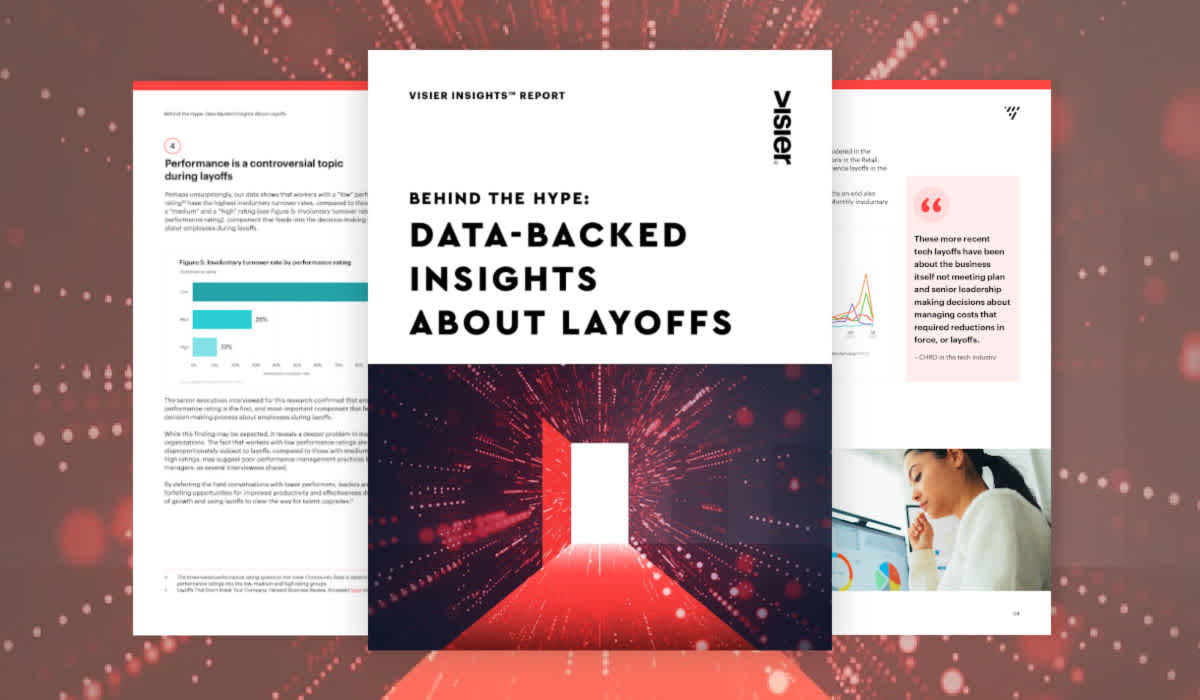The Better Way to Handle Workforce Reduction
Carrying out a workforce reduction can be tricky and sensitive. Use these four steps to determine the right strategy for your organization.

Navigating a workforce reduction is a tricky and sensitive process, especially when unexpected emergencies, such as a worldwide pandemic or a recession, forces substantial changes to the economy.
Rumors of recession are growing stronger as the end of 2022 gets closer. In the U.S. the majority of CEOs are bracing for recession, while in the U.K. resignations are waning as employees are fearful of finding their next job in an uncertain economic climate.
To adapt to the current state of business, your company, like many others, has to take measures to determine the best way to manage their headcount today, and as the situation continues to evolve.
There are other ways to weather a looming economic downturn that you can act on now, answering these questions:
What alternatives do you have to downsizing?
What headcount reduction strategies should you adopt?
How to ensure you make fact-based decisions?
The use of people analytics in reducing headcount can provide HR managers with the data necessary to make the most informed and beneficial decision for their organizations.
In this article, discover the steps to take in integrating data into your headcount reduction process and making the best financial decisions—while minimizing the impact on your people.
Rightsizing and its alternatives
Putting people first takes on a whole new meaning during these extraordinary times. Because we are in the midst of a public health crisis that impacts absolutely everyone, leaders want to ensure they are doing the right thing for their employees, their families, and their communities.
Avoiding job cuts whenever possible requires thoughtful risk-taking tactics:
The difference between rightsizing and downsizing
Workforce reduction strategies in a downturn economy
1. The difference between rightsizing and downsizing
“Rightsizing” your workforce is the process of making sure you have the right people in the organization and balancing cost constraints with the need for more, less, or different talent. Right-sizing is particularly challenging when the future is so uncertain.
Downsizing on the other hand refers to the permanent reduction of a company’s workforce and is generally associated with corporate reorganization.
2. Workforce reduction strategies in a downturn economy
Even when the financial outlook is grim, however, there are alternatives to across-the-board job cuts.
Read this post to learn if these cost-saving ideas are better short-term and long-term strategies for your organization:
Natural attrition: Attrition is a gradual voluntary reduction in staff numbers that occurs as employees retire, resign or are dismissed and are not replaced.
Hiring freeze: A hiring freeze is when an employer temporarily freezes non-essential hiring of employees to reduce costs.
Reskilling: When you reskill your workforce, you essentially change the skill set of your team.
Limiting overtime: Overtime refers to hours worked by employees that exceed their normally scheduled working hours.
Furloughs: A furlough is a temporary leave of absence or reduced work schedule from which the employee is expected to return to work.

Re-examining the headcount reduction process
If your organization needs to move forward with a reduction, who decides which employee gets laid off?
Typically, Finance departments make the call for cost reduction and relay the message to HR leaders to cut costs across the organization. Without the use of data, leaders often go with “gut feel” after considering who will be least critical in achieving departmental goals in the coming year.
Other organizations go with the expected “last in, first out” methodology, in which those with the shortest tenure are the first to be let go. Another strategy is to let go of the most expensive people, thereby saving the most money while letting go of the fewest staff.
In all these cases, an evidence-based process is missing.
PwC’s 21st CEO Survey calls for the use of analytics in transforming and restructuring how organizations work. In the case of layoffs, HR leaders benefit from using people analytics to inform their decision-making.
HR leaders need the right people data so that they can quantify where the organization sits in terms of skills, roles, and operational requirements. It may seem counterintuitive, but a precise understanding of cost constraints and talent capacity can actually lead to more creative thinking.
For one healthcare organization, having people analytics has been very beneficial. The organization needed to reduce nurse headcount in a hospital with a declining patient count. To do this, they looked at the costs to acquire and retain new nurses in the affected location, as well as at retirements compared to their other locations.
Their people analytics revealed that promoting early retirements would help them reach their targets. The direct costs of laying off the new nurses would have been $1.5 million. By letting natural attrition take place, this healthcare organization did not need to let a single new nurse go. They ended up saving $400,000 as a direct cash saving.

4 steps to determine the right workforce reduction strategy
If your organization needs to move forward with a headcount reduction, people analytics enables you to gain a clearer picture of the situation and opens up the range of possibilities for tackling cost challenges.
Using analytics also offers more flexibility in terms of modeling various cost scenarios to make the best financial decisions–while minimizing the human impact.
Discover four data-driven steps to determining the right reduction in force strategy:
Gather information for strategy planning
Run potential scenarios
Determine the mitigation plan
Monitor the impacts
Step 1: Gather information for strategy planning
While Finance may have a number they expect HR to hit by a certain date, it is ultimately up to HR to determine the strategy of who, when, and how when it comes to formulating the people behind the numbers.. HR leaders should ask several questions of their Finance team, and then use people analytics to drill deeper and determine the best solution, such as:
Is the reduction across the organization, within a specific geography, or within a specific work type?
Are we trying to reduce overall costs or reduce costs in a particular area due to a shortage of work?
Why do we need to cut costs? Is there less work to do or do we need to do the work at lower costs?
Understanding the “why” behind Finance targets allows you to find the right solution—and it isn’t always reducing headcount! By knowing the prospective future state of the business, HR can produce solutions that match and work towards business goals.
Step 2: Run potential scenarios
Once you understand why Finance targets have been set and what future state they’re working towards, it’s possible to start running different scenarios on how best to reduce employee counts.
In looking to reduce headcount, perform “what-if” analyses to explore different layoff scenarios, as well as alternatives to letting people go. For example, you could test how implementing early retirement could deliver Finance’s targets over time.
With analytics, you’re better able to see the possible outcomes of your decisions before you have to make them.
Step 3: Determine the mitigation plan
After looking at the planning and what-if data, HR leaders must determine mitigation steps to ensure that reducing headcount is controlled. Keep in mind that turnover contagion can occur as a result of layoffs.
Refer to Curbing Employee Turnover Contagion to learn how to use people analytics to ward against this phenomenon.
Consider the following steps in creating your headcount reduction strategy:
Identify high performers that need to be kept and implement targeted retention strategies such as merit increases —this may seem counter-intuitive, but keeping top talent who generate the most value for your organization offsets any increase in pay.
Determine if there is a need to ramp up in one department before ramping down in another.
Step 4: Monitor the impacts
People analytics is essential in monitoring the effects of your organization reduction. The goal of reducing employee counts is often to save costs or help the business perform better, so it is imperative that you monitor the aftermath of a reduction in workforce.
Check metrics like the retention of high performers, maintenance of labor costs against delivery of revenue or productivity targets, and the number of new applicants to indicate any possible issues or opportunities as a result of the headcount reduction.
How to motivate the downsizing survivors
Harvard Business Report reports that downsizing can result in decreased loyalty of employees who remain in the organization and found that layoff survivors experienced a 20% decrease in productivity. This can be attributed, in part, to research that shows that employees “catch each other’s feelings” while working in groups. Disengagement can be contagious. Leaders in organizations that are downsizing need to be especially mindful of this.
Leadership is the key to keeping your workforce engaged during this crisis. One recent study shows that employee engagement is actually at an all time high. Beyond that, two of the biggest factors contributing to this high level of engagement are leadership support and internal communication. Supporting your employees in this time is critical to keep your organization on track, and may even inspire meaningful changes for your company.
Interested in learning more? Continue Reading:
On the Outsmart blog, we write about workforce-related topics like what makes a good manager, how to reduce employee turnover, and employee burnout. We also report on trending topics like the Great Resignation and preparing for a recession, and advise on HR best practices like how to present headcount data to your CEO, metrics every CHRO should track, and connecting people data to business data. But if you really want to know the bread and butter of Visier, read our post about the benefits of people analytics.


